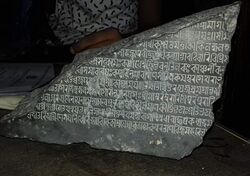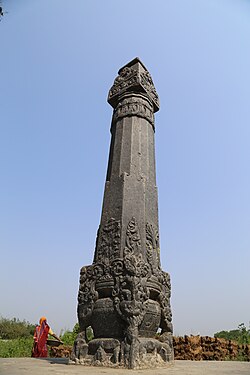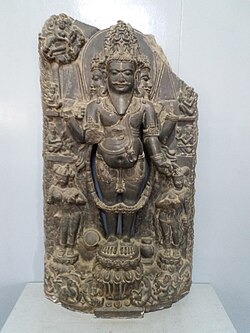History:Karnat dynasty
Karnatas of Mithila Karnata dynasty | |
|---|---|
| 1097 CE–1324 CE | |
| Capital |
|
| Religion | Hinduism |
| Government | Monarchy |
| Historical era | Medieval India |
• Established | 1097 CE |
• Disestablished | 1324 CE |
The Karnat or Karnata dynasty (Script error: The function "transl" does not exist.) was a dynasty established in 1097 CE by Nanyadeva. The dynasty had two capitals, namely Simraungadh in modern day Bara District, Nepal and Darbhanga, Bihar. The latter city became the second capital during the reign of Gangadeva.[1] The kingdom controlled the areas we today know as Tirhut or Mithila in the Bihar state of India and Nepal. This region is bounded by the Mahananda River in the east, the Ganges in the south, the Gandaki River in the west and by the Himalayas in the North.[2][3] Under the Karnats, Mithila enjoyed almost full sovereignty from 1097 until 1324.[4]
According to French orientalist and indologist Sylvain Lévi, Nanyadeva established his supremacy over Simraungadh probably with the help of the Chalukya king Vikramaditya VI.[5][6][7] After the reign of Vikramaditya VI in 1076 CE, he led a successful military campaign against the Pala dynasty and the Sena dynasty.[8][9] During the reign of Harisimhadeva, the Karnats also carried out raids into Nepal with the Karnat army under the leadership of the general and minister, Caṇḍeśvara Ṭhakkura.[10]
History
Origins
The origins of the Karnats of Mithila (Karnas) lie within South India. Sena dynasty inscriptions refer to Nanyadeva as Karnata-Kulabhusana indicating that he had his origins in the South (Vatapi, Karnataka) and likely arrived in the North through the Chalukya invasions. His ancestors were petty chieftains and adventurers in Eastern India and Nanyadeva carved out his own kingdom in Mithila.[11]
When Nanyadeva first arrived in the region in 1093 A.D., he originally established his stronghold in Nanapura in Champaran, Bihar and referred to himself as Mahashamantadhipati as confirmed by the local traditions of Mithila. The title suggests that he was likely originally a commander in the Chalukaya army. He later shifted his capital to Simraungadh.[12]
Nanyadeva's reign
The reign of Nanyadeva can be precisely dated by an inscribed stone pillar at Simraungadh which says, translated into English, "In the Śaka year 1019, on Saturday, the 7th of śrāvaṇa, in the śvāti nakṣatra, king Nānyadeva took the land."[13]:234 This corresponds to a date of 10 July 1097 CE.[14]:35[note 1]
The Mithila region had formerly belonged to the Kalachuris of Tripuri. At some point (probably c. 1122), the Kalachuri king Yashahkarna appears to have invaded in an attempt to recapture the territory. Based on the Berighati inscription, it seems that Yashahkarna's invasion caused significant devastation to the region but was ultimately unsuccessful, and after his retreat in 1124 or 1125, the Kalachuris made no more attempts to reconquer the region.[13]:240–1
Another event that happened during Nanyadeva's reign was a clash of some sort with the Sena ruler Vijayasena, possibly because both of them were trying to win territory in the east. The Deopara inscription, authored by the poet Umapatidhara under Vijayasena's direction, describes Nanyadeva as a "defeated hero" who Vijayasena took as a prisoner. It says nothing about Vijayasena conquering Mithila, though, so while he may have inflicted a major defeat on Nanyadeva, Nanyadeva remained an independent ruler. Whatever the exact nature of this event, it seems to have left Nanyadeva a "negligible factor in North Indian politics" compared to the Senas and Gahadavalas.[13]:243–51
At some point, possibly after the tussle with Vijayasena, Nanyadeva got involved in the Nepal region. According to Upendra Thakur, Nanyadeva may have championed Śivadeva, a prince of the Thakuri dynasty (which had been dethroned by another branch by around 1080), in his bid for the throne. By doing so, he expanded his own influence in Nepal.[13]:251 According to Sinha, the relationship between Nanyadeva and Śivadeva (who ruled between c. 1118 and 1123) is more uncertain – Nanyadeva may have supported Śivadeva, but they may have also been rivals.[14]:49 The nature of Nanyadeva's authority in Nepal is also unclear. According to Thakur, Nanyadeva probably had "a loose sort of hegemony over the princes of Nepal", with the local princes recognising his nominal suzerainty but otherwise remaining mostly independent.[13]:252–3
According to local tradition, Nanyadeva's original capital was at Nānyapura in the present-day Champaran districts of Bihar, where ruins are still visible. Nepalese tradition, on the other hand, says Nanyadeva had his capital at Simraungadh. Whenever the shift happened, Simraungadh went on to serve as the main capital for the later Karnat rulers, while Nānyapura ended up becoming abandoned, and no later traditions or documents mention it.[13]:241, 51–2
Nanyadeva also apparently wrote a commentary on the Nāṭyaśāstra.[14]:50
Downfall
Harisimhadeva (r. 1295 to 1324 CE), the sixth descendant of Nanyadeva was the last Karnat sovereign of Tirhut. During the later years of his reign, the Tughlaq dynasty came to power, which ruled the Delhi Sultanate and most of Northern India from 1320 to 1413 CE. In 1324 CE, the founder of the Tughlaq dynasty and Sultan of Delhi, Ghiyasuddin Tughlaq, turned his attention towards Bengal.[15][10] The Tughlaq army invaded Bengal. On his way back to Delhi, the Sultan heard about Simraungarh, which was flourishing inside the jungle.[16] Harisimhadeva turned out to be the last king of the Karnata dynasty as he didn't show his strength and left the fort when he heard the news of an army of the Tughlaq Sultan approaching Simraungarh.[17] The Sultan and his troop stayed there for 3 days and cleared the dense forest. Finally on day 3, the army attacked and entered into the huge fort whose walls were tall and surrounded by 7 big ditches.[18]
The remains are still scattered all over the Simroungarh region. The king Harisimha Deva fled northwards into what is now Nepal. The son of Harisimhadeva, Jagatsinghadeva, married the widow princess of Bhaktapur, Nayak Devi.[19]

Legacy
Under the Karnatas, Mithila experienced a period of relative peace which allowed for authors, poets and artists to receive royal patronage. The Maithili language grew strongly during this period as new literature and folk songs were created. The philosopher, Gangeśa Upādhyāya, introduced the Navya-Nyāya school of thought which remained active in India until the 18th century. The general religious attitude of the people was conservative and the priestly aristocracy of Maithil Brahmins dominated the royal court.[20] The Varna Ratnakara of Jyotirishwar Thakur was also composed during the reign of Harisimhadeva.
Rulers
There is debate as to who succeeded Nanyadeva as ruler of the Karnat dynasty of Mithila as he had two sons, Gangadeva and Malladeva. Most scholars agree that Gangadeva was the ruler. However, it is generally accepted that Malladeva formed his own stronghold in the village of Bheet-Bhagwanpur.[1] The rulers of Karnat dynasty are as follows:
| S.N. | Name of the rulers | Timeline | Notes |
|---|---|---|---|
| 1 | Nanyadeva[21] | 1097 - 1147 CE[22] | |
| 2 | Gangadeva[21] | 1147 - 1187 CE[22] | |
| 3 | Narsimhadeva[21] | 1187 - 1227 CE[22] | |
| 4 | Ramasimhadeva[21] | 1227 - 1285 CE[22] | |
| 5 | Shaktisimhadeva[21] | 1285 - 1304 CE[22] | |
| 6 | Harisimhadeva[21] | 1304 - 1324 CE[22] |
Later Karnats
After Harisimhadeva fled Mithila, evidence exists of Karnat Kings still ruling some parts of the region up to the 15th century during the same time when the Oiniwar dynasty controlled central Mithila. In Champaran, the ruler was Prithvisimhadeva and his successors including Madansimhadeva. Their territory extended up to Gorakhpur district. Prithvisimhadeva was considered to be a descendant of Harisimhadeva. Other remnants of the Karnat dynasty were also found in Saharsa and Madhepura districts, where inscriptions have been found that refer to a ruler called Sarvasimhadeva.[23]
Descendants
It is said that after his defeat, Harisimhadeva fled to Kathmandu where his descendants became the founders of the Malla dynasty of Kathmandu. The Mallas were noted to be great patrons of the Maithili language.[24]
It is also said that another branch of the Karnats remained in Mithila and their descendants became the Gandhavariya Rajputs of North Bihar who held many chiefdoms in the region.[25][26]
Architecture
Inscriptions and artefacts related to Karnat dynasty have been found throughout the Mithila region including in both Simraungadh and Darbhanga. From Simraungadh, steles have been recovered that resemble Pala-Sena art. This was likely due to the close contact the kingdoms had with each other due to being neighbours, which allowed for cultural exchange. Many of these steles depict various Hindu goddesses and are typical of Bihar's artistic output in the second half of the 12th century, especially in relation to the ornaments.[27]
See also
- Simraungadh
Notes
References
- ↑ 1.0 1.1 CPN Sinha (1974). "A Critical Evaluation of sources for identification of Gangeyadeva of Tirabhukti". Proceedings of the Indian History Congress 35: 39–42.
- ↑ Jha, M. (1997). "Hindu Kingdoms at contextual level". Anthropology of Ancient Hindu Kingdoms: A Study in Civilizational Perspective. New Delhi: M.D. Publications Pvt. Ltd. pp. 27–42. ISBN 9788175330344. https://books.google.com/books?id=A0i94Z5C8HMC&pg=PA27.
- ↑ Mishra, V. (1979). Cultural Heritage of Mithila. Allahabad: Mithila Prakasana. pp. 13. https://books.google.com/books?id=8FBuAAAAMAAJ&q=area+of+mithila.
- ↑ Pankaj Jha (20 November 2018). A Political History of Literature: Vidyapati and the Fifteenth Century. OUP India. ISBN 978-0-19-909535-3. https://books.google.com/books?id=8xl9DwAAQBAJ.
- ↑ Magazine, New Spolight. "Sylvain Lévi's Le Népal" (in en). https://www.spotlightnepal.com/2012/10/19/sylvain-l%C3%A9vis-le-n%C3%A9pal/.
- ↑ Majumdar, Ramesh Chandra (1957). The Struggle For Empire. Bharatiya Vidya Bhavan, 1957. p. 47. https://archive.org/details/in.ernet.dli.2015.97375.
- ↑ Levi, Sylvain (2015-02-18) (in en). Le Népal: Étude Historique D'Un Royaume Hindou - Scholar's Choice Edition. Creative Media Partners, LLC. ISBN 9781297173240. https://books.google.com/books?id=oUdIrgEACAAJ.
- ↑ Somers, George E. (1977) (in en). Dynastic History Of Magadha. Abhinav Publications. ISBN 9788170170594. https://books.google.com/books?id=gYO25eaDrqUC&dq=B.P.+Sinha+in+George+E.+Somers&pg=PA253.
- ↑ Mukherjee, Ramkrishna; Mukherjee, Roopali (1974) (in en). Rise and Fall East India. NYU Press. ISBN 9780853453154. https://books.google.com/books?id=addWCgAAQBAJ&dq=Majumdar,+R.+C.+(1952),+p.320&pg=PA293.
- ↑ 10.0 10.1 Choudhary, Radhakrishna (1970) (in en). History of Muslim rule in Tirhut, 1206-1765, A.D.. Chowkhamba Sanskrit Series Office. p. 61. https://archive.org/details/HistoryOfMuslimRuleInTirhut/page/n61/mode/2up.
- ↑ Sinha, CPN (1969). "Origin of the Karnatas of Mithila - A Fresh Appraisal". Proceedings of the Indian History Congress 31: 66–72.
- ↑ Shrestha, Shiv Raj. "Nanyadeva, his ancestors and their Abhijana (Original Homeland)" (in en). Ancient Nepal. http://himalaya.socanth.cam.ac.uk/collections/journals/ancientnepal/pdf/ancient_nepal_159_01.pdf.
- ↑ 13.0 13.1 13.2 13.3 13.4 13.5 Thakur, Upendra (1956). History of Mithila (Circa 3000 BC - 1556 AD). Darbhanga: Mithila Institute. https://archive.org/details/dli.ernet.505783/mode/2up. Retrieved 30 August 2023.
- ↑ 14.0 14.1 14.2 14.3 Sinha, C. P. N. (1979). Mithila Under the Karnatas (C. 1097-1325 A.D.). https://archive.org/details/72754/mode/2up. Retrieved 30 August 2023.
- ↑ Peter Jackson (16 October 2003). The Delhi Sultanate: A Political and Military History. Cambridge University Press. pp. 199–200. ISBN 978-0-521-54329-3. https://books.google.com/books?id=lt2tqOpVRKgC&pg=PA199.
- ↑ Thapa, Netra Bahadur (1981). A Short History of Nepal. Ratna Pustak Bhandar. pp. 38–39. https://pahar.in/mountains/Books%20and%20Articles/Nepal/1981%20A%20Short%20History%20of%20Nepal%20by%20Thapa%20s.pdf.
- ↑ 'Abdoosi Akhsatan Dehlavi, Muhammad Bin Sadr Taj (1301–1335) (in fa). Basateen ul-Uns. Islamic Culture & Relations Organizations, Iran. pp. 21. http://archive.org/details/BasateenUl-Uns-MuhammadBinSadrTajAbdoosiAkhsitanDehlaviFarsi.
- ↑ Abdul Malik Isami (1948) (in fa). Futuh us-Salatin. Madras University Islamic Series No. 9. Madras: University of Madras. pp. 38–39. http://archive.org/details/FutuhUs-SalatinFarsi.
- ↑ "Simroungarh | Nepal | Heritage & Archaeological Site". https://simroungarh.wix.com/home.
- ↑ Sinha, CPN (1973). "Some aspects of cultural life of Mithila under the Karnatas (c. 1097 to 1325 A.D.)". Proceedings of the Indian History Congress 34: 170.
- ↑ 21.0 21.1 21.2 21.3 21.4 21.5 Hodgson, B. H. (1835). "Account of a Visit to the Ruins of Simroun, once the capital of the Mithila province". Journal of the Asiatic Society 4: 121−124. https://archive.org/details/JournalOfTheAsiaticSocietyOfBengalVolIv1835.
- ↑ 22.0 22.1 22.2 22.3 22.4 22.5 Chaudhary, Radhakrishna (in hi). Mithilak Itihas. Ram Vilas Sahu. pp. 70–112. ISBN 9789380538280. https://books.google.com/books?id=JO4toCiJ2ecC.
- ↑ CPN Sinha (1970). "Decline of the Karnatas of Mithila". Proceedings of the Indian History Congress 32: 79–84.
- ↑ Brinkhaus, Horst (1991). "The Descent of the Nepalese Malla Dynasty as Reflected by Local Chroniclers". Journal of the American Oriental Society 111 (1): 118–122. doi:10.2307/603754.
- ↑ P. Pathak (1983). "Origin of the Gandhavaria Rajputs of Mithila". The Journal of the Bihar Puravid Parisad Vii And Viii: 406–420. https://archive.org/details/in.ernet.dli.2015.283324.
- ↑ Bindeshwari Prasad Sinha (1974). Comprehensive History Of Bihar Vol.1; Pt.2. https://archive.org/details/in.ernet.dli.2015.534083/page/n339. Retrieved 8 January 2019.
- ↑ Cimino, Rosa Maria (1986). "Simraongarh: The Forgotten City and its art". Contributions to Nepalese Studies 13: 277–288. https://lib.icimod.org/record/9735. Retrieved 7 August 2020.
 |



